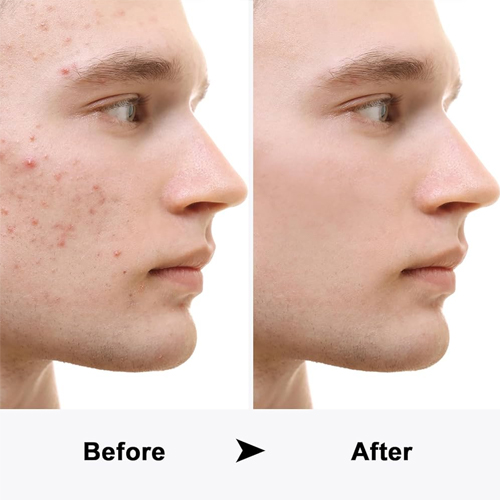Acne and pimples are common skin conditions that affect people of all ages, often leading to discomfort and a desire for clear, healthy skin. This guide will explore the causes of acne, different types of treatments available, and how to manage and prevent breakouts effectively.
What is Acne?
Acne is a skin condition that occurs when hair follicles become clogged with oil (sebum) and dead skin cells. It can manifest as whiteheads, blackheads, pimples, cysts, or nodules, primarily on the face, neck, shoulders, back, and chest. While acne is most common among teenagers, it can affect individuals at any age.
Causes of Acne
- Hormonal Changes: Fluctuations in hormones, especially during puberty, menstruation, pregnancy, and menopause, can increase oil production and lead to acne.
- Excess Oil Production: Overactive sebaceous glands produce excess sebum, clogging pores.
- Bacteria: The bacterium Propionibacterium acnes (P. acnes) can thrive in clogged pores, causing inflammation.
- Diet: High-glycemic foods and dairy products may trigger or worsen acne in some individuals.
- Stress: Stress can exacerbate acne by increasing hormone levels that stimulate oil production.
- Genetics: A family history of acne can increase the likelihood of developing the condition.
- Skincare Products: Using comedogenic (pore-clogging) cosmetics and skincare products can contribute to acne.
Types of Acne Treatments
-
Topical Treatments
- Benzoyl Peroxide: Kills acne-causing bacteria and helps clear clogged pores. Available over-the-counter in various strengths.
- Salicylic Acid: Exfoliates the skin and helps unclog pores. Often found in cleansers, toners, and spot treatments.
- Retinoids: Derived from vitamin A, retinoids promote cell turnover and prevent clogged pores. Available in both over-the-counter and prescription forms.
- Antibiotics: Topical antibiotics like clindamycin and erythromycin reduce bacteria and inflammation. Often combined with other treatments.
-
Oral Medications
- Antibiotics: Oral antibiotics like doxycycline and minocycline reduce bacteria and inflammation for moderate to severe acne.
- Hormonal Treatments: Birth control pills and anti-androgen medications like spironolactone can regulate hormones and reduce acne in women.
- Isotretinoin: A powerful oral retinoid used for severe, treatment-resistant acne. It significantly reduces oil production and can lead to long-term remission.
-
In-Office Procedures
- Chemical Peels: Use acids to exfoliate the skin and unclog pores. Effective for treating mild to moderate acne.
- Laser and Light Therapy: Target and reduce P. acnes bacteria and inflammation. Options include blue light therapy and fractional lasers.
- Extraction: Manual removal of blackheads and whiteheads by a dermatologist.
- Corticosteroid Injections: Reduce inflammation and shrink large, painful cysts quickly.
-
Natural and Home Remedies
- Tea Tree Oil: Has antibacterial properties that can help reduce acne when applied topically.
- Aloe Vera: Soothes inflammation and promotes healing.
- Honey and Cinnamon Mask: Both have antibacterial properties and can reduce acne when used as a mask.
Preventing Acne Breakouts
-
Skincare Routine
- Gentle Cleansing: Wash your face twice daily with a gentle, non-comedogenic cleanser.
- Exfoliation: Use a mild exfoliant to remove dead skin cells and prevent clogged pores.
- Moisturizing: Use a non-comedogenic moisturizer to keep your skin hydrated without clogging pores.
- Sun Protection: Apply a broad-spectrum sunscreen daily to protect your skin from UV damage.
-
Lifestyle Changes
- Healthy Diet: Eat a balanced diet rich in fruits, vegetables, whole grains, and lean proteins. Limit high-glycemic foods and dairy if they trigger your acne.
- Hydration: Drink plenty of water to keep your skin hydrated.
- Stress Management: Practice stress-reducing techniques like meditation, yoga, and regular exercise.
- Avoid Touching Your Face: Reduce the transfer of bacteria and oil by keeping your hands away from your face.
-
Avoiding Acne Triggers
- Non-Comedogenic Products: Use makeup, skincare, and hair products labeled as non-comedogenic or oil-free.
- Regular Cleaning: Change pillowcases, towels, and face cloths regularly to prevent bacteria buildup.
- Avoid Over-Washing: Washing your face too frequently can strip it of natural oils, leading to increased oil production and acne.
Potential Risks and Side Effects
- Skin Irritation: Topical treatments can cause redness, dryness, and peeling. Start with lower concentrations and gradually increase as tolerated.
- Sun Sensitivity: Some acne treatments, particularly retinoids and certain antibiotics, can increase your skin's sensitivity to the sun. Use sunscreen and limit sun exposure.
- Antibiotic Resistance: Overuse of antibiotics can lead to resistance. Use antibiotics only as prescribed and for the recommended duration.
Choosing the Right Treatment
- Consultation: Schedule a consultation with a dermatologist to discuss your skin type, acne severity, and treatment options.
- Personalization: Your dermatologist will create a personalized treatment plan based on your specific needs and goals.
- Patience: Acne treatments take time to show results. Be consistent with your regimen and give treatments several weeks to months to work.


